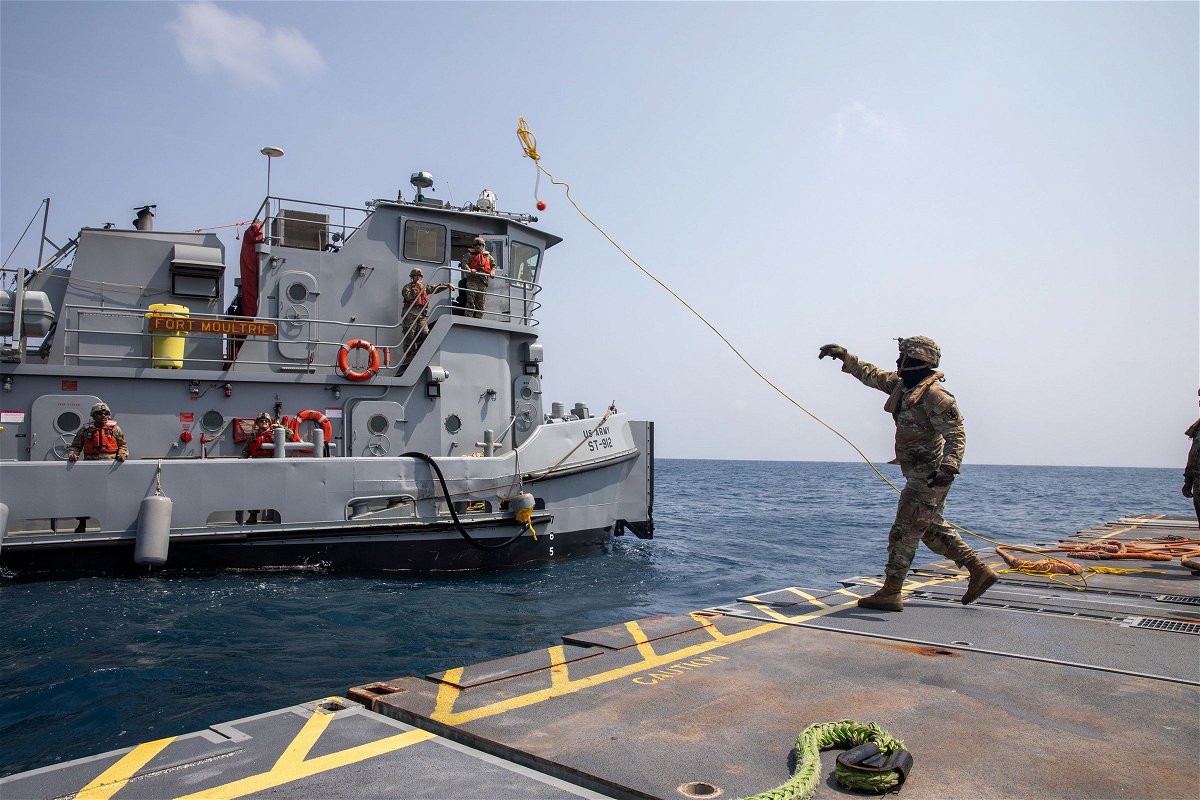US-built floating pier that will allow delivery of humanitarian aid has been anchored in Gaza

(CNN) — The floating pier that will allow for humanitarian aid to flow into Gaza from the sea has been anchored to a beach in Gaza, according to US Central Command (CENTCOM).
Personnel anchored the pier at about 7:40 a.m. local time, “supporting the humanitarian mission to deliver additional humanitarian aid to Palestinian civilians,” CENTCOM said in a statement. The pier had traveled on Wednesday from the port of Ashdod, about 30 miles away, to the Gaza beach.
Trucks are expected to begin moving the humanitarian aid ashore in the coming days, while the United Nations will coordinate distribution within the besieged strip, CENTCOM said, adding that no US troops had entered Gaza.
The Joint Logistics Over-the-Shore (JLOTS) system consists of two parts: the floating pier where shipments will be offloaded and the causeway to transfer the shipments to the distribution point in Gaza.
On Wednesday, the UK announced that its first shipment of humanitarian aid, including 8,400 temporary shelters, is on its way from Cyprus to Gaza. Cyprus is the staging point for the humanitarian aid that will be shipped to Gaza through the maritime corridor and the pier.
“The aid will be distributed within Gaza as soon as feasible,” the UK said in its announcement.
Meanwhile, US humanitarian aid is already positioned on a ship at the Ashdod port for offloading when the pier is ready, the Pentagon has said.
The temporary pier is intended to supplement the aid going in through the land crossings into Gaza. The initial goal is to allow 90 truckloads of aid to enter Gaza each day through the pier, the UK said, a number that could increase to 150 truckloads per day when the pier is fully operational.
In a news briefing on Wednesday, Vice Adm. Brad Cooper, the deputy commander of the US Central Command, stressed that the pier was not intended to replace land routes into Gaza, and there would be “no US military boots on the ground in Gaza.”
He also laid out how the process would go. First, the aid arrives in Cyprus where it is screened and prepared. Then, large commercial ships bring that aid to a “floating platform” near the Gaza coast, where it is then transferred to smaller vessels that can dock at the temporary pier. Once ashore, the aid will be distributed into Gaza by the UN and World Food Program.
There are currently “hundreds of tons of aid ready for delivery and thousands of tons of aid in the pipeline,” from multiple nations, Cooper said.
Last week, CNN reported that the US still faced a number of obstacles before JLOTS could begin operations. The US was closely watching whether what it called a “limited” Israeli incursion into Rafah in southern Gaza would affect the temporary pier. In addition, the US had not yet finalized plans about who would transport the humanitarian aid shipments from the causeway to the distribution point in Gaza.
On Monday, the Pentagon said it had contracted drivers for the pier, though it declined to identify the drivers.
“I can just tell you it’s a third-party contractor, but that’s it,” deputy Pentagon press secretary Sabrina Singh said at a press briefing. Once the humanitarian aid arrives in Gaza, the UN World Food Program will distribute it to the Palestinian population.
On Tuesday, Ryder said security was in place to allow JLOTS operations to begin when the pier was ready.
“We’re confident that we’ll have the security in place that we need,” Ryder said.
JLOTS will cost approximately $320 million to operate for the first three months, according to the Pentagon.
In the briefing, Cooper also addressed security concerns, saying the US and Israel have developed a plan to protect all personnel working on the project in the area, though he did not share more specific details.
Dan Dieckhaus, the response director of USAID, acknowledged there is “constant risk” – but added that JLOTS and the causeway are not “exposed to any additional risk above and beyond that which is already present in Gaza.”
The-CNN-Wire
™ & © 2024 Cable News Network, Inc., a Warner Bros. Discovery Company. All rights reserved.